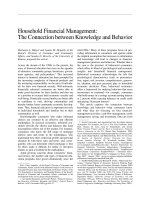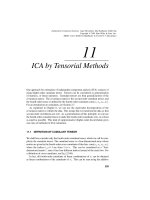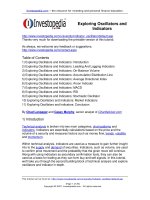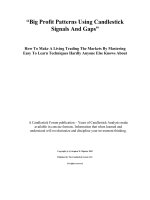Simulation Concepts and Methods doc
Bạn đang xem bản rút gọn của tài liệu. Xem và tải ngay bản đầy đủ của tài liệu tại đây (285.9 KB, 12 trang )
1
Chapter 9: Simulation
Concepts and Methods
Project risk analysis by
simultaneous adjustment
of forecast values.
2
Introduction
Simulation allows the repeated
solution of an evaluation model.
Each solution randomly selects
values from predetermined
probability distributions.
All solutions are summarized into
an overall distribution of NPV
values.
This distribution shows
management how risky the project
is.
3
Simulation Terminology
The treatment of risk by using simulation
is known as ‘stochastic’ modeling.
Other names for our term ‘Simulation’,
are - ‘Risk Analysis’, ‘Venture
Analysis’,’Risk Simulation’, ‘Monte Carlo
Simulation’.
The name ‘Monte Carlo Simulation’
helps visualization of repeated spins of
the roulette wheel, creating the selected
values.
Each execution of the model is known as
a ‘replication’ or ‘iteration’.
4
The Role of Simulation
Follows the initial creation and basic
testing of the representative model.
Is sometimes used as a test of the model.
Emphasizes the need for formal
forecasting, and requires close
specification of the forecast variables.
Draws managements attention to the
inherent risk in any project.
Focuses attention on accurate model
building.
5
Probability Distributions
of Forecast variables
Uniform: upper and lower
bounds required.
6
Probability Distributions
of Forecast variables
Uniform: upper and lower
bounds required.
Triangular: pessimistic,
most likely, and optimistic
values required
7
Probability Distributions
of Forecast variables
Uniform: upper and lower
bounds required.
Triangular: pessimistic,
most likely, and optimistic
values required
Normal: mean and variance
required.
8
Probability Distributions of Forecast
Variables
Uniform: upper and lower
bounds required.
Triangular: pessimistic, most
likely, and optimistic values
required
Normal: mean and variance
required.
Exponential: initial value and
growth factor required.
9
Process of Computation
per Replication
A value of a variable is selected from
its distribution using a random
number generator.
For example: Sales 90 units; selling
price per unit $2,350; component cost
per unit $1,100; labour cost per unit
$280.
These values are incorporated into
the model, and an NPV is calculated
for this replication.
The NPV for this replication is stored,
and later reported as one of many in
an overall NPV distribution.
10
Making the Replications
Each replication is unique.
Selection of values from the
distribution is made according to
the particular distributions
The automated process is driven
by a random number generator.
Excel add-ons such as ‘@Risk’ and
‘Insight’ can be used to streamline
the process.
About 500 replications should give
a good picture of the project’s risk.
11
Using the Output
Management can view the risk
of the project.
Probability of generating an
NPV between two given values
can be calculated.
Probability of loss is the area to
the left of a zero NPV.
12
Benefits and Costs of Simulation
Focuses on a detailed definition and analysis
of risk.
Sophisticated analysis clearly portrays the
risk of a project
Gives the probability of a loss making project
Allows simultaneous analysis of variables
Requires a significant forecasting effort.
Can be difficult to set up for computation.
Output can be difficult to interpret.









